Motion In A Straight Line MCQs
NEET Physics For Motion In A Plane Multiple Choice Questions
Question 1. Which of the following is not a vector quantity?
- Speed
- Velocity
- Torque
- Displacement
Answer: 1. Speed
Speed is a scalar quantity. It gives no idea about the direction of motion of the object. Velocity is a vector quantity, as it has both magnitude and direction. Displacement is a vector as it possesses both magnitude and direction. When an object goes on the path ABC (in figure), then the displacement of the object is AC. The arrowhead at C shows that the object is displaced from A to C.
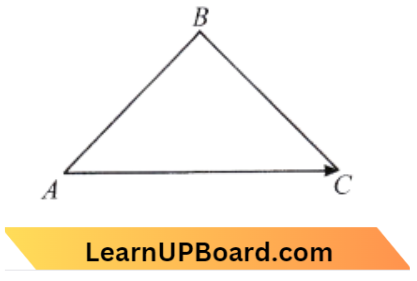
Torque is the turning effect of force which is a vector quantity.
Question 2. Vectors \(\vec{A}, \vec{B}\) ,and \(\vec{C}\) are such \(\vec{A} \cdot \vec{B}=0 \quad \vec{A} \cdot \vec{C}=0\). Then the vector parallel to A is:
- \(\vec{A}×\vec{B}\)
- \(\vec{B}+\vec{C}\)
- \(\vec{B}×\vec{C}\)
- \(\vec{B}\) and \(\vec{C}\)
Answer: 3. \(\vec{B}×\vec{C}\)
From Vector Product,\(\vec{A} \times(\vec{B} \times \vec{C})=(\vec{A} \cdot \vec{C}) \vec{B}-(\vec{A} \cdot \vec{B}) \vec{C}\)
Given that:
⇒ \(\vec{A} \cdot \vec{B}=0, \vec{A} \cdot \vec{C}\)=0,
then\(\vec{A} \times(\vec{B} \times \vec{C})\)=0
∴Thus vector A is paralle to \(\vec{B} \times \vec{C}\).
Question 3. If \(\vec{A}=\vec{A}+\vec{C}\) and their magnitude in ratio 5:4:3 respectively, then angle between vector \(\vec{A} \text { and } \vec{C}\) is:
- 53°
- 90°
- 60°
- 18°
Answer: 1. 53°
From question,\(\vec{A}=\vec{B}+\vec{C}\) means \(\vec{A}-\vec{C} =\vec{B}\)
Read and Learn More NEET Physics MCQs
⇒ Now, \((\vec{A}-\vec{C})(\vec{A}-\vec{C}) =\vec{B} \cdot \vec{B}\)
\(\overrightarrow{A^2}+\overrightarrow{C^2}-2 \vec{A} \cdot \vec{C} =B^2\)(Self product at both sides)
⇒ \(\overrightarrow{A^2}+\overrightarrow{C^2}-2 \vec{A} \vec{C} \cos \theta=\overrightarrow{B^2}\)
Where θ is the angle between A and C.
⇒ \(\cos\theta=\frac{\overrightarrow{A^2}+\overrightarrow{C^2}-\overrightarrow{B^2}}{2 A C}\)
=\(\frac{(5)^2+(3)^2-(4)^2}{2 \times 5 \times 3}=\frac{18}{30}=\frac{3}{5}\)
⇒ \(\cos \theta=\frac{3}{5}\)
∴ \(\theta=\cos ^{-1}\left[\frac{3}{5}\right]=53^{\circ}\)
Motion in a Straight Line MCQs
Question 4.\(\overrightarrow{\mathrm{A}} \text { and } \overrightarrow{\mathrm{B}}\) are two vectors and 0 is the angle between them, if \(|\overrightarrow{\mathrm{A}} \times \overrightarrow{\mathrm{B}}|=\sqrt{3}(\overrightarrow{\mathrm{A}} \cdot \overrightarrow{\mathrm{B}})\)), the value of θ is:
- 45°
- 30°
- 90°
- 60°
Answer: 4. 60°
⇒ \(|\vec{A}+\vec{B}|=\sqrt{3}(\vec{A} \cdot \vec{B})\)
⇒ \(\vec{A} \vec{B} \sin \theta=\sqrt{3} \vec{A} \vec{B} \cos \theta\)
⇒ \(\tan \theta=\sqrt{3}\)
∴ \(\theta=60^{\circ}\)
Question 5. The vectors \(\vec{A} \text { and } \vec{B}\) are such that \(|\vec{A}+\vec{B}|=|\vec{A}-\vec{B}|\). The angle between the two vectors is:
- 45°
- 90°
- 60°
- 75°
Answer: 2. 90°
According to the question, \(|\vec{A}+\vec{B}| =|\vec{A}-\vec{B}|\)
⇒ \(\quad|\vec{A}+\vec{B}|^2 =|\vec{A}-\vec{B}|^2\)
⇒ \(\overrightarrow{A^2}+\overrightarrow{B^2}+2 \vec{A} \vec{B}=\overrightarrow{A^2}+\overrightarrow{B^2}-2 \vec{A} \vec{B}\)
⇒ \(4 \vec{A} \cdot \vec{B}=0\)
∴ \(\vec{A} \cdot \vec{B}\) =0
⇒ \(\quad \vec{A} \vec{B} \cos \theta\) =0
⇒ \( \quad \theta =90^{\circ}\)
∴ \([As \vec{A}=\vec{B} \neq 0 ]\)
MCQs on Motion in a Straight Line for NEET
Question 6. If a vector \(2 \hat{i}+3 \hat{j}+8 \hat{k}\) is perpendicular to the vector \(4 \hat{i}-4 \hat{j}+\alpha \hat{k}\) then the value of a is:
- \(\frac{1}{2}\)
- A
- 1
- -1
Answer: 2. A
⇒ \(\vec{a}=2 \hat{i}+3 \hat{i}+8 \hat{k}\)
⇒ \(\vec{b}=4 \hat{i}-4 \hat{j}+\alpha \hat{k}\)
⇒ Since \(\vec{a} \text { and } b \text { are perpendicular, }\)
∴ So,\(\vec{a} \cdot \vec{b}\)=0,
⇒ \((2 \hat{i}+3 \hat{j}+8 \hat{k}) \cdot(4 i+4 j+2 k) =\frac{1}{2}\)
⇒ \(8+12+8 \alpha\)=0
∴ \(\alpha =-\frac{1}{2}\)
Question 7. If the angle between the vector\(\vec{A} \text { and }(\vec{B} \times \vec{A}) \cdot \vec{A}\) 0, the value of the product \((\vec{B} \times \vec{A}) \cdot \vec{A}\) is equal to:
- BA2 sin θ
- BA2 cos θ
- BA2 sin θ cos θ
- zero
Answer: 4. zero
⇒ \((\vec{B} \times \vec{B}) \vec{A}=(B A \sin \theta)(\vec{n} \cdot \vec{A})\)=0
∴ Since n is perpendicular to both \(\vec{A} \text { and } \vec{B}\)
MCQs on Motion in a Straight Line for NEET
Question 8. If \(|\vec{A} \times \vec{B}|=\sqrt{3} \vec{A} \cdot \vec{B} \text { then the value of }|\vec{A} \times \vec{B}| \text { is: }\)
- \(\left(A^2+B^2+A B\right)^{1 / 2}\)
- \(\left(A^2+B^2+\frac{A B}{\sqrt{3}}\right)^{\frac{1}{2}}\)
- A+B
- \(\left(A^2+B^2+\sqrt{3} A B\right)^{\frac{1}{2}}\)
Answer: 1. \(\left(A^2+B^2+A B\right)^{1 / 2}\)
According To Question, \(\vec{A} \times \vec{B} =\sqrt{3} \vec{A} \cdot \vec{B}\)
⇒ \(\vec{A} \vec{B} \sin \theta =\sqrt{3} \vec{A} \vec{B} \cos \theta\)
⇒ \(\quad \tan \theta=\sqrt{3}\)
⇒ \(\quad \theta =60^{\circ}\)
∴ \(\quad|\vec{A}+\vec{B}| =\sqrt{|\vec{A}|^2+|\vec{B}|^2+2|\vec{A}||\vec{B}| \cos \theta}\)
Question 9. What is the linear velocity, if angular velocity vector ω = \(3 \hat{i}-4 \hat{j}+\hat{k}\) and position vector r = \(5 \hat{i}-6 \hat{j}+6 \hat{k}\)
- \((A)6 \hat{i}+2 \hat{j}-3 \hat{k}\)
- \(-18 \hat{i}-13 \hat{j}+2 \hat{k}\)
- \(18 \hat{i}+13 \hat{j}-2 \hat{k}\)
- \(6\hat{i}-2 \hat{j}+8 \hat{k}\)
Answer: 2. \(-18 \hat{i}-13 \hat{j}+2 \hat{k}\)
The relation between linear velocity v, angular velocity to, and position vector r is given by,

∴ This confirms from the above that velocity remains constant.
Motion in a Straight Line NEET Questions
Question 10. The resultant of A x 0 will be equal to:
- zero
- A
- zero vector
- unit vector
Answer: 3. zero vector
According to the properties of vector product, the cross product of any vector with zero is a null vector or zero vector.
Question 11. If the magnitude of the sum of two vectors is equal to the magnitude of the difference between the two vectors, the angle between these vectors is:
- 90°
- 45°
- 180°
- 0°
Answer: 1. 90°
From the question, if \(\vec{A} \text { and } \vec{B}\) are two vectors, then
⇒ \(|\vec{A}+\vec{B}|=|\vec{A}+\vec{B}|\)
A2 + B2 + 2AB cos θ = A2+ B2– 2AB cos θ
⇒ 4AB cos θ = 0
cos θ = 0
∴θ = 90°
Question 12. The vector sum of two forces is perpendicular to their vector differences. In this case, the force:
- are equal to each other
- are equal to each other in magnitude
- are not equal to each other in magnitude
- cannot be predicted
Answer: 2. are equal to each other in magnitude
⇒ \((\overrightarrow{\mathrm{A}}+\overrightarrow{\mathrm{B}})\cdot(\overrightarrow{\mathrm{A}}-\overrightarrow{\mathrm{B}})=0\)
⇒ \(\mathrm{~A}^2-\overrightarrow{\mathrm{A}} \cdot \overrightarrow{\mathrm{B}}+\overrightarrow{\mathrm{B}} \cdot \overrightarrow{\mathrm{A}}-\mathrm{B}^2 =0\)
∴ \(\overrightarrow{\mathrm{A}}=\overrightarrow{\mathrm{B}} \quad \overrightarrow{\mathrm{A}} \cdot \overrightarrow{\mathrm{B}}=\overrightarrow{\mathrm{B}} \cdot \overrightarrow{\mathrm{A}})\)
Motion in a Straight Line NEET Questions
Question 13. The magnitudes of vectors A, B, and C are 3, 4, and 5 units respectively. If A + B = C, the angle between A and B is:
- \(\frac{\pi}{2}\)
- \(\cos ^{-1}(0.6)\)
- \(\tan ^{-1}\left(\frac{7}{5}\right)\)
- \(\frac{\pi}{4}\)
Answer: 1. \(\frac{\pi}{2}\)
From Figure, \(\overrightarrow{\mathrm{A}}+\overrightarrow{\mathrm{B}}=\overrightarrow{\mathrm{C}}\)
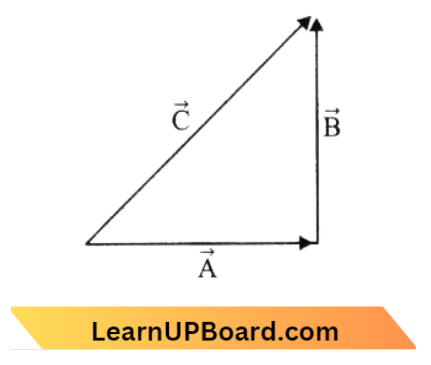
⇒ Also,\(|\vec{A}|=3,|\vec{B}|=4,|\vec{C}|\)=5
⇒ As \(\quad \overrightarrow{\mathrm{A}}+\overrightarrow{\mathrm{B}}=\overrightarrow{\mathrm{C}}\)
So,\(\quad 5^2=3^2+4^2+2.4 .3 \cos \theta\)
⇒ \(\cos \theta\)=0
⇒ \(\quad \theta=\frac{\pi}{2}\)
∴ \(\vec{A} \text { is perpendicular to } \vec{B}\)
Question 14. If vectors A=\(\cos \omega t \hat{i}+\sin \omega t \hat{j} and B=\cos \frac{\omega t}{2} \hat{i}+\sin \frac{\omega t}{2} \hat{j}\) are functions of time, then the value of t at which they are orthogonal to each other:
- \(t=\frac{\pi}{4 \omega}\)
- \(\frac{\pi}{2 \omega}\)
- t=\(\frac{\pi}{\omega}\)
- t=0
Answer: 3. t=\(\frac{\pi}{\omega}\)
⇒ Given,\(\vec{A}=\cos \omega t \hat{i}+\sin \omega t \hat{j}\) and \(\vec{B}=\cos \frac{\omega t}{2} \hat{i}+\sin \frac{\omega t}{2} \hat{j}\)
Since, they are orthogonal to each other, \(\vec{A} \cdot \vec{B}=0\)
⇒ \((\cos \omega t \hat{i}+\sin \omega t \hat{j}) \cdot\left(\cos \frac{\omega t}{2} \hat{i}+\sin \frac{\omega t}{2} \hat{j}\right)\)=0
⇒ \(\cos \omega t \cdot \cos \frac{\omega t}{2}+\sin \omega t \cdot \sin \frac{\omega t}{2}\)=0
⇒ \(\{\hat{i} \cdot \hat{i}=1, \hat{j} \cdot \hat{j}=1\}\)
⇒ \(\cos \left(\omega t-\frac{\omega t}{2}\right)\)=0
⇒ \( \cos \mathrm{A} \cos \mathrm{B}+\sin A \cdot \sin B=\cos (A-B)\}\)
∴ ⇒\(\cos \frac{\omega t}{2}\)=0
⇒ \(\quad \frac{\omega t}{2}=\frac{\pi}{2}\)
∴ \(\quad t=\frac{\pi}{\omega}\)
Class 11 Motion in a Straight Line MCQs
Question 15. The between the vectors \(\mathrm{A}=3 \hat{i}+4 \hat{j}+5 \hat{k} \text { and } \mathrm{B}=3 \hat{i}+4 \hat{j}-5 \hat{k}\) will be:
- 0°
- 45°
- 90°
- 180°
Answer: 3. 90°
The angle between two vectors is given as from dot product A.B = |A| |B| cosθ
cosθ = \(\frac{\mathrm{A} \cdot \mathrm{B}}{\mathrm{AB}}\)
∴ Here,\(\mathrm{A}=3 \hat{i}+4 \hat{j}+5 \hat{k}\)
⇒ \(\mathrm{~B}=3 \hat{i}+4 \hat{j}-5 \hat{k}\)
⇒ \(\mathrm{~A}=\sqrt{(3)^2+(4)^2+(5)^2}=\sqrt{50}\)
⇒ \(\mathrm{~B}=\sqrt{(3)^2+(4)^2+(-5)^2}=\sqrt{50}\)
And,\(\mathrm{~A} \cdot \mathrm{B}=(3 \hat{i}+4 \hat{j}+5 \hat{k}) \cdot(3 \hat{i}+4 \hat{j}-5 \hat{k})\)=9+16-25=0
⇒ \(\cos \theta=\frac{0}{\sqrt{50} \cdot \sqrt{50}}\)=0
∴\(\theta=90^{\circ}\)
Question 16. The magnitudes of vectors A, B, and C are 3, 4, and 5 units respectively. If A + B = C, the angle between A and B is:
- \(\frac{\pi}{2}\)
- \(\cos ^{-1}(0.6)\)
- \(\tan ^{-1}\left(\frac{7}{5}\right)\)
- \(\frac{\pi}{4}\)
Answer: 1. \(\frac{\pi}{2}\)
In the Figure shown, A+B=C
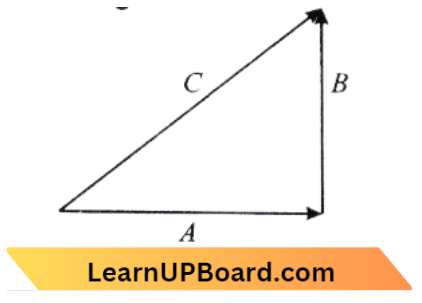
⇒ Also,\(\quad|\mathrm{A}|=3,|\mathrm{~B}|=4,|\mathrm{C}|=5\)
⇒ As\(\quad \mathrm{A}+\mathrm{B}=\mathrm{C}\)
⇒ So,\(\quad 5^2=3^2+4^2+2 \cdot 4 \cdot 3 \cos \theta\)
⇒ \(\cos \theta=0=90^{\circ}\)
∴A=is perpendicular to B.
Question 17. Six vectors a through / have the magnitudes and direction indicated in the figure. Which of the following statements is true?
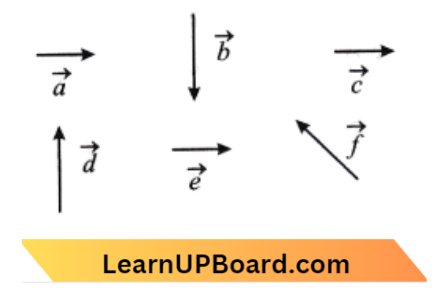
- \(\vec{b}+\vec{b}=\vec{f}\)
- \(\vec{d}+\vec{c}=\vec{f}\)
- \(\vec{d}+\vec{e}=\vec{f}\)
- \(\vec{b}+\vec{e}=\vec{f}\)
Answer: 3. \(\vec{d}+\vec{e}=\vec{f}\)
According to the parallelogram law of vector addition, we can say that \(\vec{d}+\vec{e}=\vec{f} \text {correct}\)
Question 18. A car starts from rest and accelerates at 5m/s 2. At t=4s, a ball is dropped out of a window by a person sitting in the car. What is the velocity and acceleration of the ball at t = 6 s?
- 20 m/s, 5 m/s2
- 20 m/s, 0
- 20 √2 m/s, 0
- 20 √2 m/s, 10 m/s2
Answer: 4. 20√2 m/s, 10 m/s2
Given that initial velocity u=0
⇒ Acceleration a=5 m/s2
At t=4 ball is dropped.
⇒ velocity of the car at t = 4 sec,
v=u+at
⇒ v=0+5(4):20m/s
At t = 6 sec, acceleration is due to gravity.
⇒ a = g = 10mls
vx=20 m/s (due to car)
⇒ vy=u+at =0+g(2)(downward)
=20 m/s(downward)
v = sq.rt (202 + 202) = 20 sq.rt2
Class 11 Motion in a Straight Line MCQs
Question 19. A particle moves in the x-y plane according to the rule x = a sin ω and y = a cos ωt. The particle follows:
- an elliptical
- a circular path
- a parabolic path
- a straight line path inclined equally to the x and y-axis
Answer: 2. a circular path
It is given that,x=\(a \sin \omega t\)
⇒ \(\frac{x}{a} =\sin \omega t\) → equation..1
y =\(b \cos \omega t\)
⇒ \(\frac{x}{b} =\cos \omega t\) → equation.. 2
From equation 1,2
⇒ \(\frac{x^2}{a^2}+\frac{y^2}{b^2} =1\)
∴ \(x^2+y^2 =a^2\)
Question 20. A ball is thrown vertically downward with a velocity of 20 m/s from the top of a tower. It hits the ground after some time with a velocity of 80 m/s. The height of the tower is (g = 10m/s²):
- 340m
- 320m
- 300m
- 360m
Answer: 3. 300m
Given that u=20 m/s, v=80 m/s and h = ? using third equation of motion
⇒ \(v^2 =u^2+2 g h\)
h=\(\frac{v^2-u^2}{2 g}\)
=\(\frac{(80)^2-(20)^2}{2 \times 10}\)=300m
Question 21. When an object is shot from the bottom of a long smooth inclined plane kept at an angle of 60° horizontal it can travel a distance x1 along the plane. But when the inclination is decreased to 30° and the same object is shot with the same velocity, it can travel x2 distance. Then x1 : x2 will be
- √2:1
- 1:√3
- 1:2√3
- 1:√2
Answer: 2. 1:√3
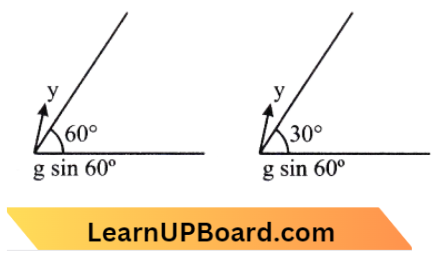
⇒ Stopping distance, x1=\(\frac{u^2}{2 g \sin 60^{\circ}}\)
⇒ Stopping distance, x2=\(\frac{u^2}{2 g \sin 30^{\circ}}\)
⇒ \(\frac{x_1}{x_2}=\frac{\sin 30^{\circ}}{\sin 60^{\circ}}\)
=\(\frac{1 \times 2}{2 \times \sqrt{3}}=\frac{1}{\sqrt{3}}\)
=\(1:\sqrt{3}\)
Class 11 Motion in a Straight Line MCQs
Question 22. A particle moving with velocity v is acted by three forces shown by the vector triangle PQR. The velocity of the particle will

- decreases
- remain constant
- change according to the smallest force QR
- increase
Answer: 1. decreases
Net Force=0
⇒ \(\vec{a} =0\)
⇒ F =\(m vec{a}\)
a=\(\frac{F}{m}\)
∴ \(\vec{a} =0\)
Question 23. An object flying in air with velocity \((20 \hat{i}+25 \hat{j}-12 \hat{k})\) suddenly breaks into two pieces whose masses are in the ratio 1:5. The smaller mass flies off with a velocity \((100 \hat{i}+25 \hat{j}-8 \hat{k})\). The velocity of the larger piece will be :
- \(4 \hat{i}+23 \hat{j}-8 \hat{k}\)
- \(-100 \hat{i}-35 \hat{j}-8 \hat{k}\)
- \(20 \hat{i}+15 \hat{j}-80 \hat{k}\)
- \(-20 \hat{i}-15 \hat{j}-80 \hat{k}\)
Answer: 1. \(4 \hat{i}+23 \hat{j}-8 \hat{k}\)
Given
An object flying in air with velocity \((20 \hat{i}+25 \hat{j}-12 \hat{k})\) suddenly breaks into two pieces whose masses are in the ratio 1:5. The smaller mass flies off with a velocity \((100 \hat{i}+25 \hat{j}-8 \hat{k})\).
Let m be the mass of the object that is flying with velocity \((20 \hat{i}+25 \hat{j}-12 \hat{k})\) is in the air. According to the question, the mass breaks into two pieces of ratio 1: 5, which means the small piece is \(\frac{7 m}{6}\)and another piece is \(\frac{5 m}{6}.\)
Using the law of conservation of momentum,
Initial momentum = Final momentum
⇒ \(\not h(20 \hat{i}+25 \hat{j}-12 \hat{k})=\frac{\not h}{6}(100 \hat{i}+35 \hat{j}-8 \hat{k})+\frac{5}{6} \not h v\)
⇒ \((120 \hat{i}+150 \hat{j}-72 \hat{k}) =(100 \hat{i}+35 \hat{j}+8 \hat{k})+5 v\)
v =\(\frac{1}{5}(20 \hat{i}+115 \hat{j}-80 \hat{k})\)
∴v=\(4 \hat{i}+23 \hat{j}-16 \hat{k}\)
Class 11 Motion in a Straight Line MCQs
Question 24. A body initially at rest and sliding along a frictionless track from a height h (as shown in the figure) just completes a vertical circle of diameter AB = D. The height h is equal to:
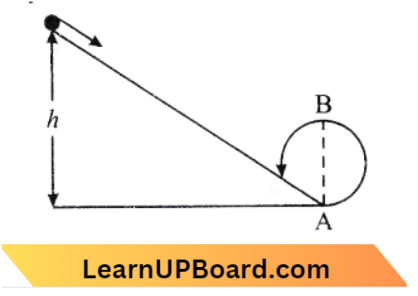
- \(\frac{7}{5} \mathrm{D}\)
- D
- \(\frac{3}{2} D\)
- \(\frac{5}{4} D\)
Answer: 4. \(\frac{5}{4} D\)
Since the track is frictionless.
⇒ So, total mechanical energy remains constant.
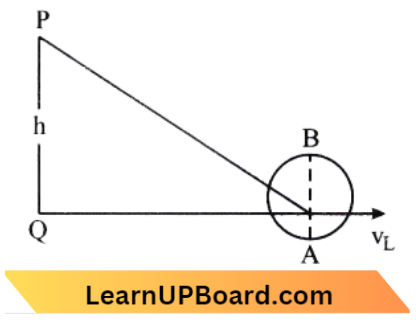
Total Mechanical Energy1 Total Mechanical Energy2
⇒ 0+mgh =\(\frac{1}{2} m v_{\mathrm{L}}^2+m g \Delta\)
⇒ h =\(\frac{v_{\mathrm{L}}{ }^2}{2 g}\)
For completing the verticle circle,
⇒ \(v_L \geq \sqrt{g \mathrm{R}}=\sqrt{\frac{\Delta g}{2}}\)
mg =\(\frac{1}{2} m \frac{\Delta}{2} g+m g \Delta\)
∴ h =\(\frac{5}{4} \Delta\)
Class 11 Motion in a Straight Line MCQs
Question 25. One end of the string of length 1 is connected to a particle of mass m and the other end is connected to a small peg on a smooth horizontal table. If the particle moves in a circle with speed v, the net force on the particle (directed towards the center) will be (T represents the tension in the string):
- T
- \(T+\frac{m v^2}{l}\)
- \(T-\frac{m v^2}{l}\)
- Zero
Answer: 1. T
Given
One end of the string of length 1 is connected to a particle of mass m and the other end is connected to a small peg on a smooth horizontal table. If the particle moves in a circle with speed v,
According to the question, string l connected to a particle is shown below.

⇒ Since the particle is in a uniform circular motion, the net force is equal to the centripetal force.
Centripetal force = Net force
∴ \(\frac{m v^2}{l}=T\)
Question 26. Two cars P and Q start from a point at the same time in a straight line and their positions are represented by Xp(t) = at + bt² and Xqt =ft – t². At what time do the cars have the same velocity?
- \(\frac{a-t}{1+b}\)
- \(\frac{a+t}{2(b-1)}\)
- \(\frac{a+f}{2(1+b)}\)
- \(\frac{f-a}{2(1+b)}\)
Answer: 4. \(\frac{f-a}{2(1+b)}\)
Position of car P, Xp(t) = at + bt²
velocity of car P,\(v_P=\frac{d x_p(t)}{d t}=a+2 b t\)
⇒ Position of car Q,\(x_{\mathrm{Q}}(t)=t-t^2\)
velocity of car Q,\(v_Q=f-2 t\)
Since, \( V_P=V_Q\)
a+2bt=t-2 t
∴ t=\(\frac{f-a}{2(b+1)}\)
Important MCQs on Motion in a Straight Line
Question 27. Two particles A and B move with constant velocities v1 and v2. At the initial moment, their position vectors are r1 and r2 respectively. The condition for particles A and B for their collision is:
- \(\frac{r_1+r_2}{\left|r_1-r_2\right|}=\frac{v_2+v_1}{\left|v_2-v_1\right|}\)
- \(r_1 \cdot v_1=r_2 \cdot v_2\)
- \(r_1 \times v_1=r_2 \times v_2\)
- \(r_1-r_2=v_1-v_2\)
Answer: 1. \(\frac{r_1+r_2}{\left|r_1-r_2\right|}=\frac{v_2+v_1}{\left|v_2-v_1\right|}\)
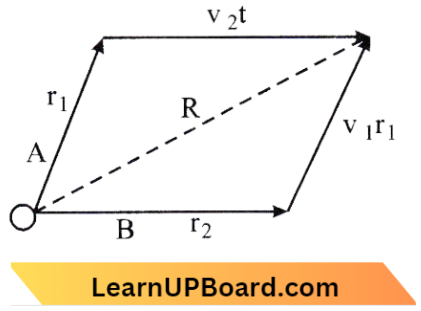
Displacement OF Particle is \(R=r_1+v_1 t=r_2+v_2 t\)
⇒ \(\text { i.e. } r_1-r_2=\left(v_2-v_1\right) t\)
= \(\frac{r_1-r_2}{\left|r_1-r_2\right|}=\frac{\left|v_2-v_1\right|}{\left|v_2-v_1\right|} t\)
∴ \(\frac{r_1-r_2}{\left|r_1-r_2\right|}=\frac{\left(v_2-v_1\right)}{\left|v_2-v_1\right|}\)
Question 28. A particle is moving such that its position coordinates (x, y) are (2 m, 3 m) at time t = 0, (6 m, 7 m) at time t = 2 s and (13 m, 14 m) at time t = 5 s. Average velocity vector (Vav) from / = 0 to t = 5 s is:
- \(\frac{1}{5}(13 \hat{i}+13 \hat{j})\)
- \(\frac{7}{3}(\hat{i}+\hat{j})\)
- \(2(\hat{i}+\hat{j})\)
- \(\frac{11}{5}(\hat{i}+\hat{j})\)
Answer: 4. \(\frac{11}{5}(\hat{i}+\hat{j})\)
Here, Net displacement,\(\overrightarrow{\mathrm{S}}_1=(13-2) \hat{i}+(4-3) \hat{j}=11 \hat{i}+11 \hat{j}\) and Time taken (5-0) = 5 sec
⇒ Average Velocity ,Vav=\(\frac{\text { Net displacement }}{\text { Taken time }}\)
= \(\frac{11 \hat{i}+11 \hat{j}}{5}\)
= \(\frac{11}{5}(\hat{i}+\hat{j})\)
Important MCQs on Motion in a Straight Line
Question 29. The velocity of a projectile at the initial point A is \((2 \hat{i}+3 \hat{j})\) m/s. Its velocity (in m/s) at point B will be:
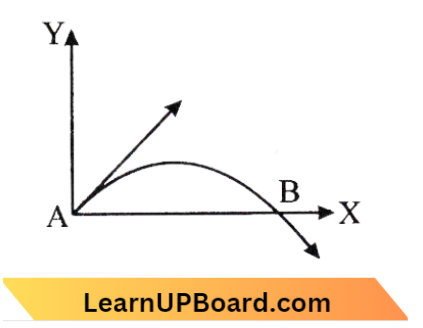
- \(-2 \hat{i}-3 \hat{j}\)
- \(-2 \hat{i}+3 \hat{j}\)
- \(2 \hat{i}-3 \hat{j}\)
- \(2 \hat{i}+3 \hat{j}\)
Answer: 3. \(2 \hat{i}-3 \hat{j}\)
From the graph, the x-component remains unchanged and the component is reversed. So, the velocity at point B is (21 -3 j) ms-1.
∴ [Here x-compound does not change and change y-component]
Question 30. A particle has initial velocity \((3 \hat{i}+4 \hat{j})\) and has . acceleration \((0.4 \hat{i}+0.3 \hat{j})\). Its speed after 10 s is:
- 7 unit
- 1√2 unit
- 8.5 unit
- 10 unit
Answer: 2. 1√2 unit
We Know That the First Equation OF Motion
v =u+a t
⇒ \(\vec{v} =(3 \hat{i}+4 \hat{j})+(0.4 \hat{i}+0.3 \hat{i}) 10\)
=\(3 \hat{i}+4 \hat{j}+4 \hat{i}+3 \hat{j}\)
⇒ \(\vec{v} =7 \hat{i}+7 \hat{j}\)
⇒ \(|v|=\sqrt{7^2+7^2}=\sqrt{49+49}\)
= \(7 \sqrt{2} \mathrm{~m} / \mathrm{s}\)
Important MCQs on Motion in a Straight Line
Question 31. The mass of a lift is 2000 kg. When the tension in the supporting cable is 28000 N, then its acceleration is:
- 30 ms-2 downwards
- 4 ms-2 upwards
- 4 ms-2 downwards
- 14 ms-2 upwards
Answer: 2. 4 ms-2 upwards
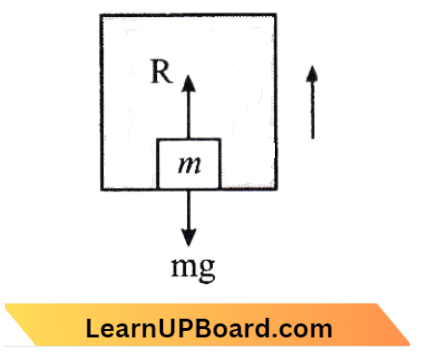
⇒ When the lift is accelerating upward, Apparent weight > actual weight the equation becomes, R – mg = ma
28000 – 20000 = 2000 a
∴ \(a=\frac{8000}{2000}=4 \mathrm{~ms}^{-2} \text { upwards }\)
Physics MCQs for NEET with Answers
Question 32. An object of mass 3 kg is at rest. Now a force \(\vec{F}=6 t^2 \hat{i}+4 t \hat{j}\) is applied on the object, then the velocity of the object at t = 3 s is:
- \(18 \hat{i}+3 \hat{j}\)
- \(18 \hat{i}+6 \hat{j}\)
- \(3 \hat{i}+6 \hat{j}\)
- \(18 \hat{i}+4 \hat{j}\)
Answer: 4. \(18 \hat{i}+4 \hat{j}\)
Let the velocity along x and y-axes be vx and vy respectively\(v_x=\frac{d x}{d t} \text { and } v_{\mathrm{y}}=\frac{d y}{d t}\)
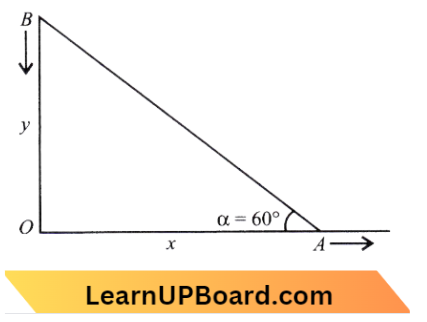
⇒ From figure,\(\tan \alpha=\frac{y}{x}\)
⇒ \(y=x \tan \alpha\)
Differentiating Equation 1 We Get
⇒ \(\frac{d y}{d t}=\frac{d x}{d t} \tan \alpha\)
⇒ \(v_y=v_x \tan \alpha\)
∴ \(v_x=10 \tan 60^{\circ} =10 \sqrt{3}=17.3 \mathrm{~m} / \mathrm{s}\)
Physics MCQs for NEET with Answers
Question 33. Two particles A and B are connected by a rigid rod AB. The rod slides along perpendicular rails as shown here. The velocity of A to the right is 10 m/s. What is the velocity of B when angle a = 60°?
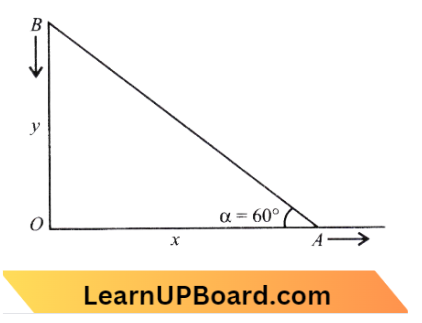
- 9.8m/s
- 10m/s
- 5.8m/s
- 17.3m/s
Answer: 2. 10m/s
From Question, \(\vec{a}=\frac{\vec{F}}{m}=2 t^2 \hat{i}+\frac{4}{3} t \hat{j}\)
⇒ \(d \vec{V}=\left(2 t^2 \hat{i}+\frac{4}{3} t \hat{j}\right) d t\)
⇒ Integrate On Both,we get\(\vec{V} =2\left[\frac{t^3}{3}\right] \hat{i}+\frac{4}{3}\left[\frac{t^2}{2}\right] \hat{j}\)
∴ \(\text { At } t=3 \sec , \vec{V} =\frac{2}{3}(3)^3 i+\frac{4}{6}(3)^2 j =18 \hat{i}+6 \hat{j}\)
Question 34. The position vector of a particle is r=\((\mathrm{a} \cos \omega t) \hat{i}+ (\mathrm{a} \sin \omega t) \hat{j}\) The velocity of the particle is
- directed toward the origin
- directed away from the origin
- parallel to the position vector
- perpendicular to the position vector
Answer: 4. perpendicular to the position vector
velocity is rate of change of position vector, i.e.,\(\mathrm{v}=\frac{d \boldsymbol{r}}{d t}\) where r is the position vector.\(\mathbf{v}=\frac{d}{d t}[(\mathrm{a} \cos \omega t) \hat{i}+(\mathrm{a} \sin \omega t) \hat{j}]\)
=\((-\mathrm{a} \omega \sin \omega t) \hat{i}+(\mathrm{a} \omega \cos \omega t)\)
=\(\omega[(-\mathrm{a} \sin \omega t) \hat{i}+(\mathrm{a} \cos \omega t) \hat{j}]\)
Slope Of Position Vector\(=\frac{a \sin \omega t}{a \cos \omega t}=\tan \omega t\)
And Slope OF Velocity Vector=\(\frac{-a \cos \omega t}{a \sin \omega t}= -\frac{1}{\tan \omega t}\)
∴ Velocity Is Perpendicular To The Displacement.
Chapter-Wise Physics MCQs for NEET
Question 35. A person standing on the floor of an elevator drops a coin. The coin reaches the floor in time t1 if the elevator is at rest and in time t2 if the elevator is moving uniformly. Then:
- t1 < t2 or t1 > t2 depending on whether the lift is going up or down
- t1 < t2
- t1 > t2
- t1 = t2
Answer: 4. t1 = t2
⇒ In both cases, elevation is an internal frame of reference. So, effective gravity remains the same in both frames.
∴ Hence, the time of fall remains the same in both cases. (Since initial velocity is the same in both frames.) Hence, t1 = t2
Question 36. A block of mass m is placed on a smooth inclined wedge ABC of inclination 0 as shown in the figure. The wedge is given an acceleration towards the right. The relation between a and θ for the block to remain stationary on the wedge is:

- a=\(g \cos \theta\)
- a=\(\frac{g}{\sin \theta}\)
- a=\(\frac{g}{{cosec} \theta}\)
- a=\(g \tan \theta\)
Answer: 4. a=\(g \tan \theta\)
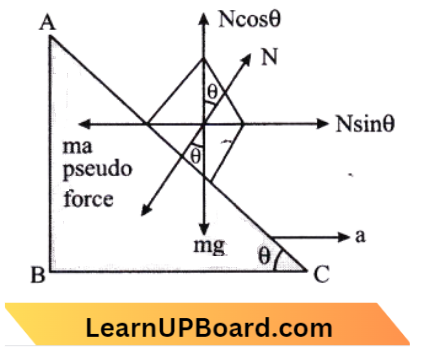
In a non-inertial frame,
⇒ At sin θ = ma → Equation-1
N cos θ = mg → Equation -2
⇒ From equation. (1) and (2), we get \(\tan \theta =\frac{a}{g}\)
∴ \(a=g \tan \theta\)
Question 37. The x and y coordinates of the particle at any time are x = 5t² – 2t² and y = 10t respectively, where x and y are in metres and t in seconds. The acceleration of the particle at t = 2 s is:
- 0
- 5 m/s²
- – 4 m/s²
- – 2m/s²
Answer: 4. – 2m/s²
Given,x=\((t+5)^{-1}\)
⇒ Velocity, v=\(\frac{d x}{d t}=(t+5)^{-2}\)
⇒ acceleration,a=\(\frac{d v}{d t}\)
⇒ \(a \propto(t+5)^{-3}\)
∴ \(\quad a^2 \propto(t+5)^{-3+2}\)
Chapter-Wise Physics MCQs for NEET
Question 38. The position vector of a particle R as a function of time is given by:
\(R=4 \sin (2 \pi t) \hat{i}+4 \cos (2 \pi t) \hat{j}\) where R in meter, t is in seconds, and \(\hat{i} \text { and } \hat{j}\)denote unit vectors along x and y-directions, respectively. Which one of the following statements is wrong for the motion of a particle?
- Acceleration is along – R.
- The magnitude of the acceleration vector is \(\frac{v^2}{R}\), where v is the velocity of the particle.
- The magnitude of the velocity of the particle is 8 m/s.
- The path of the particle is a circle of radius 4 m.
Answer: 3. Magnitude of the velocity of the particle is 8 m/s.
Given
The position vector of a particle R as a function of time is given by:
\(R=4 \sin (2 \pi t) \hat{i}+4 \cos (2 \pi t) \hat{j}\) where R in meter, t is in seconds, and \(\hat{i} \text { and } \hat{j}\)denote unit vectors along x and y-directions, respectively.
Here,\(\vec{R}=4 \sin (2 \pi t) \hat{i}+4 \cos (2 \pi t) \hat{j}\)
⇒The velocity of the particle is,\(\vec{v}=\frac{d \vec{R}}{d t}=\frac{d}{d t}[4 \sin (2 \pi t) \hat{i}+4 \cos (2 \pi t) \hat{j}]=8 \pi \cos 2 \pi t \hat{i}-8 \pi \sin (2 \pi t) \hat{j}\)
Its magnitude is\(|\vec{v}|=\sqrt{(8 \pi \cos (2 \pi t))^2+(-8 \pi \sin (2 \pi t))^2}\)
=\(\sqrt{64 \pi^2 \cos ^2(2 \pi t)+64 \pi^2 \sin ^2(2 \pi t)}\)
=\(\sqrt{64 \pi^2\left[\cos ^2(2 \pi t)+\sin ^2(2 \pi t)\right]}\)
=\(\sqrt{64 \pi^2}=8 \pi \mathrm{m} / \mathrm{s}\)
∴\(\quad\left(\text { as } \sin ^2 \theta+\cos ^2 \theta=1\right)\)
Chapter-Wise Physics MCQs for NEET
Question 39. A particle has initial velocity \((2 \hat{i}+3 \hat{j})\) and acceleration\((0.3 \hat{i}+02 \hat{j})\). The magnitude of velocity after 10 s will be:
- 9√2 units
- 5√2
- 5 units
- 9 units
Answer: 1. 9√2 units
Given that, velocity, \(\vec{u}=2 \hat{i}+3 \hat{j}\)
Acceleration, \(\vec{a}=(0.3 \hat{i}+0.2 \hat{j})\)
By the first equation of motion, v =u + at
⇒ \(v=(2 \hat{i}+3 \hat{j})+(0.3 \hat{i}+0.2 \hat{j}) \times 10 \\=5 \hat{i}+5 \hat{j}\)
∴ v =\(5 \sqrt{2} \text { units }\)
Question 40. A particle moves a distance x in time / according to equation x = (t + 5)–¹. The acceleration of the particle is proportional to:
- (velocity )3/2
- (density)2
- (distance)-2
- (velocity)2/3
Answer: 3. (distance)-2
Given,x =5t-2t2
⇒ Velocity \(v_x =\frac{d x}{d t}=\frac{d}{d t}\left(5 t-2 t^2\right)=5-4 t\)
Acceleration,\(a_x =\frac{d}{d t}(v)=\frac{d}{d t}(5-4 t)=-4 \mathrm{~m} / \mathrm{s}^2\)
Again, y=10t
⇒ Velocity \(v_y=\frac{d}{d t}(10 t)=10\)
Acceleration,\(a_y=\frac{d}{d t}\left(v_y\right)=\frac{d}{d t}(10)=0\)
∴ Net acceleration of particle,\(⇒{a_{n e t}}=a_x \hat{i}+a_y \hat{j}=-4 \hat{i}+0=-4 \hat{i} \mathrm{~ms}^{-2}=4 \mathrm{~m} / \mathrm{s}^2\)
Question 41. A particle moves in a straight line with a constant acceleration. It changes its velocity from 10 m-1 while passing through a distance of 135 m in t second. The value of t is:
- 10
- 1.8
- 12
- 9
Answer: 4. 9
For Constant Acceleration, \(v^2=u^2+2 as\)
⇒ \((2)^2 =(10)^2+2 \times 9 \times 135\)
⇒a =\(\frac{300}{270} \mathrm{~ms}^{-2}\)
⇒ As, v =\(u+a t\)
⇒ \(0+a \times t\)
⇒ 10 =\(\frac{300}{270} \times t\)
∴ t =\(9 \mathrm{sec}\)
Question 42. A ball is projected with a velocity, of 10 ms-1, at an angle of 60° with the vertical direction. Its speed and the highest point of its trajectory will be:
- 5√3 ms-1
- 5 ms1
- 10 ms-1
- zero
Answer: 1. 5 √3 ms-1
Given: velocity of ball =10 m/s,
Angle with vertical direction = 60°
⇒ From equation (1) we can say that the speed of the ball at the highest point = v cosθ where θ = 90 – 60 = 30°
⇒ \(\mathrm{v}=10 \times \cos (30)=10 \times((\sqrt{3}) / 2)\)
∴ \(\mathrm{v}=5 \sqrt{3} \mathrm{~m} / \mathrm{s}\)
Chapter-Wise Physics MCQs for NEET
Question 43. A particle moving in a circle of radius R with a uniform speed takes a time T to complete one revolution. If this particle were projected with the same speed at an angle ‘θ’ to the horizontal, the maximum height attained by it equals 4R. The angle of projection, 0, is then given by:
- \(\theta=\cos ^{-1}\left(\frac{g \mathrm{~T}^2}{\pi^2 \mathrm{R}}\right)^{\frac{1}{2}}\)
- \(\theta=\cos ^{-1}\left(\frac{\pi^2 \mathrm{R}}{g \mathrm{~T}^2}\right)^{\frac{1}{2}}\)
- \(\theta=\sin ^{-1}\left(\frac{\pi^2 \mathrm{R}}{g \mathrm{~T}^2}\right)^{\frac{1}{2}}\)
- \(\theta=\sin ^{-1}\left(\frac{2 g \mathrm{~T}^2}{\pi^2 \mathrm{R}}\right)^{\frac{1}{2}}\)
Answer: 4. \(\quad \theta=\sin ^{-1}\left(\frac{2 g \mathrm{~T}^2}{\pi^2 \mathrm{R}}\right)^{\frac{1}{2}}\)
Given,
A particle moving in a circle of radius R with a uniform speed takes a time T to complete one revolution. If this particle were projected with the same speed at an angle ‘θ’ to the horizontal, the maximum height attained by it equals 4R
Radius = R
⇒ Time = T for one revolution Angle of projection = 0
Hmax=4R , θ=?
⇒ \(\mathrm{v}=\frac{2 \pi \mathrm{R}}{\mathrm{T}}\) from circular motion.
⇒ \({H}_{\max }=\frac{\mathrm{v}_y^2}{2 g}=\frac{\mathrm{v}^2 \sin ^2 \theta}{2 g}=4 \mathrm{R}\)
⇒ \(\frac{4 \pi^2 \mathrm{R}^2}{\mathrm{~T}^2} \times \frac{\sin ^2 \theta}{2 g}=4 \mathrm{R}\)
⇒ \(\sin ^2 \theta=\frac{8 g \mathrm{~T}^2}{4 \pi^2 \mathrm{R}}=\frac{2 g \mathrm{~T}^2}{\pi^2 \mathrm{R}}\)
∴ \(\theta=\sin ^{-1}\left(\frac{2 g \mathrm{~T}^2}{\pi^2 \mathrm{R}}\right)^{1 / 2}\)
Question 44. The speed of a projectile at its maximum height is half of its initial speed. The angle of projection is:
- 60°
- 15°
- 30°
- 45°
Answer: 1. 60°
The speed of a projectile at its maximum height\(v^{\prime}=v_0 \cos \theta\)
⇒ \(\frac{v_0}{2}=v_0 \cos \theta\)
⇒ \(\cos \theta=\frac{1}{2}\)
⇒ \(\theta=60^{\circ}\)
Question 45. A projectile is fired from the surface of the earth with a velocity of 5 ms-1 and angle δ with the horizontal. Another projectile fired from another planet with a velocity of 3 ms-1 at the same angle follows a trajectory that is identical to the trajectory of the projectile fired from the Earth. The value of the acceleration due to gravity on the planet is (in ms-2) is (given, g = 9.8 ms-2):
- 3.5
- 5.9
- 16.3
- 110.8
Answer: 1. 3.5
Given
A projectile is fired from the surface of the earth with a velocity of 5 ms-1 and angle δ with the horizontal. Another projectile fired from another planet with a velocity of 3 ms-1 at the same angle follows a trajectory that is identical to the trajectory of the projectile fired from the Earth.
The equation of trajectory is y =\(x \tan \theta-\frac{g x^2}{2 u^2 \cos ^2 \theta},\) where 0 is the angle of projection and u is the velocity with which projectile is projected.
⇒ For equal trajectories and for same angles of projection,\(\frac{g}{u^2}=\text { constant }\)
As per Question,\(\frac{9.8}{(5)^2}=\frac{g^{\prime}}{(3)^2}\)
where θ is the acceleration due to gravity on the planet,\(g^{\prime}=\frac{9.8 \times 9}{25}=3.5 \mathrm{~m} / \mathrm{s}^2\)
Kinematics MCQs for NEET
Question 46. The horizontal range and the maximum height of a projectile are equal. The angle of projection of the projectile is:
- \(\theta=\tan ^{-1}\left(\frac{1}{4}\right)\)
- θ = tan-1 (4)
- θ = tan-1 (2)
- θ = 45°
Answer: 2. θ = tan’1 (4)
We know that,Range,\(R=\frac{u^2(2 \sin \theta \cos \theta)}{g}\)
⇒ H=\(\frac{u^2 \sin ^2 \theta}{2 g}\)
According To the Question, R=H
⇒ \(\frac{u^2(2 \sin \theta \cos \theta)}{g}=\frac{u^2 \sin ^2 \theta}{2 g}\)
⇒ \(2 \cos \theta=\frac{\sin 0}{2}\)
∴ \(\tan \theta =4 \theta =\tan ^{-1}(4)\)
Question 47. A missile is fired for maximum range with an initial velocity of 20 m/s, if g = 10 m/s², the range of the missile is:
- 50 m
- 60 m
- 20 m
- 40 m
Answer: 4. 40 m
∴ As we know Maximum Range, \(R_{\max }=\frac{u^2}{g}=\frac{(20)^2}{10}=40 \mathrm{~m}\)
Kinematics MCQs for NEET
Question 48. A projectile is fired at an angle of 45° with the horizontal. The elevation angle of the projectile at its highest point as seen from the point of projection is:
- \(60^{\circ}\)
- \(\tan ^{-1}\left(\frac{1}{2}\right)\)
- \(\tan ^{-1}\left(\frac{\sqrt{3}}{2}\right)\)
- \(45^{\circ}\)
Answer: 2. \(\tan ^{-1}\left(\frac{1}{2}\right)\)
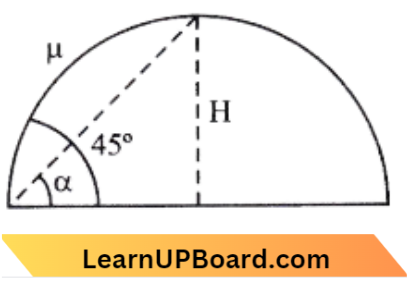
Height of Projectile,
⇒ H=\(\frac{u^2 \sin ^2 \theta}{2 g}\)
=\(\frac{u^2 \sin ^2 45^{\circ}}{2 g}=\frac{u^2}{4 g}\) Equation 1
⇒ And Range Of Projectile ,R=\(\frac{u^2 \sin 2 \theta}{g}\)
=\(\frac{u^2 \sin 90^{\circ}}{g}=\frac{u^2}{g}\) → Equation 2
⇒ \(\frac{R}{2}=\frac{u^2}{2 g}\) → Equation 2
⇒ \(\quad \tan \alpha=\frac{H}{R / 2}\)
⇒ considering eq. (1) and eq. (2)
⇒ \(\tan \alpha=\frac{1}{2}\)
∴ \(\alpha=\tan ^{-1}\left(\frac{1}{2}\right)\)
Question 49. A particle of mass is projected with velocity v making an angle of 45° with the horizontal. When the particle lends on the level ground the magnitude of the change in its momentum will be:
- 2 mv
- \(\frac{m v}{\sqrt{2}}\)
- \(m v \sqrt{2}\)
- zero
Answer: 3. \(m v \sqrt{2}\)
The situation is shown in the figure,

Change in momentum \(\vec{\Delta} P =\vec{P}_f-\vec{P}_i =m\left(\overrightarrow{\hat{v}}_f-\vec{v}_i\right)\)
= \(m\left[\left(v \cos 45^{\circ} i-v \sin 45^{\circ} j\right)\right.\left.-\left(v \cos 45^{\circ} i+v \sin45^{\circ} j\right)\right]\)
= \(m\left[\left(\frac{v}{\sqrt{2}} i-\frac{v}{\sqrt{2}} j\right)-\left(\frac{v}{\sqrt{2}} \mathrm{i}+\frac{v}{\sqrt{2}} j\right)\right]=-\sqrt{2} m v j\)
∴ \(\quad|\overrightarrow{\Delta P}|=\sqrt{2} \mathrm{mv}\)
Kinematics MCQs for NEET
Question 50. For angles of projection of the projectile at angles (45° + θ) and (45° – θ), the horizontal range described by the projectile is in the ratio of:
- 2: 1
- 1:1
- 2:3
- 1:2
Answer: 2. 1:1
⇒ Horizontal range,\(R=\frac{u^2 \sin ^2 \theta}{g}\)
When the angle of projection is (45° – 0) then
⇒ \(R_1=\frac{u^2 \sin 2\left(45^{\circ}-\theta\right)}{g}\)
= \(\frac{u^2 \sin \left(90^{\circ}-\theta\right)}{g}\)
= \(\frac{u^2 \cos 2 \theta}{g}\)
∴ Now,\(\frac{R_1}{R_2}=\frac{u^2 \cos \frac{2 \theta}{8}}{u^2 \cos \frac{2 \theta}{g}}=1: 1\)
Question 51. The maximum range of a gun on horizontal terrain is 16 km. If g = 10 ms-2, then the muzzle velocity of a shell must be:
- 160 ms-1
- 200 V2 ms-1
- 400 ms-1
- 800 ms-1
Answer: 3. 400 ms-1
Range of projectile is given by,\(R=\frac{u^2 \sin 2 \theta}{g}\)
⇒ For maximum range, the angle should be 45°.\(R_{\max }=\frac{u^2 \sin 2 \times 45}{g}\)
=\(\frac{u^2 \sin 2 \theta}{g}\)
⇒ \(R_{\text {max }}=\frac{u^2}{g}\)
⇒ \(R_{\max }=\frac{u^2}{g}=16 \mathrm{~km}=16000 \mathrm{~m}\) or
∴ u =\(\sqrt{16000 \times g}=\sqrt{16000 \times 10}=400 \mathrm{~ms}^{-1}\)
Kinematics MCQs for NEET
Question 52. An electric fan has blades of length 30 cm measured from the axis of rotation. If the fan is rotating at 120 rev/ min, the acceleration of a point on the tip of the blade is:
- 1600 ms-2
- 47.4 ms-2
- 23.7 ms-2
- 50.55 ms-2
Answer: 2. 47.4 ms-2
We have, centripetal acceleration of rotating body \(a_c=\frac{v^2}{r}=\frac{v^2 \omega^2}{r}=r \omega^2\)
Since,ω= 2πv,
∴ where v is the frequency of rotation. ac = r (2πv)² = r x 4π²V² ⇒ r =30cm = 30x 10-2m = 0.30m
⇒ \(v=120 \mathrm{rev} / \mathrm{m}=\frac{120}{60} \mathrm{rev} / \mathrm{s}=2 \mathrm{rev} / \mathrm{s}\)
∴ ac =(0.30x4x3.14×3.14x2x2) = 47.4 ms-2
Question 53. A mass m is attached to a thin wire and whirled in a vertical circle. The wire is most likely to break when:
- the wire is horizontal.
- the mass is at the lowest point.
- inclined at an angle of 60° from vertical.
- the mass is at the highest point
Answer: 2. the mass is at the lowest point.
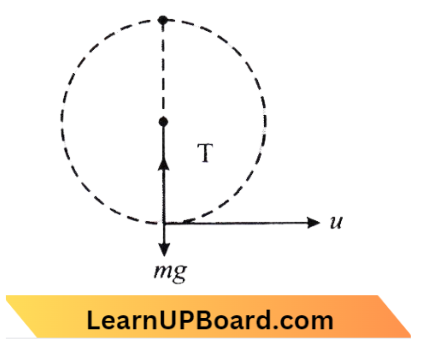
From question, \(T-m g=\frac{m u^2}{l}\)
⇒ \(T=m g+\frac{m u^2}{l}\)
∴ The tension is maximum at the lowest position of the mass, so the chance of breaking is maximum.
Question 54. A particle moves so that its position vector is given by r = cos cot x + sin cot y, where co is a constant. Which of the following statements is true?
- Velocity and acceleration both are parallel for r.
- Velocity is perpendicular to r and acceleration is directed toward the origin
- Velocity is perpendicular to r and acceleration is directed away from the origin
- Velocity and acceleration both are perpendicular to
Answer: 4. Velocity and acceleration both are perpendicular to r.
According to the question,
⇒ \(\mu m g \geq \frac{m v^2}{R}\)
⇒ \(v \geq \sqrt{\mu R g}\)
∴ \(v_{\max }=\sqrt{\mu R g}\)
Uniform and Non-Uniform Motion MCQs for NEET
Question 55. A disc and a sphere of the same radius but different masses roll off on two inclined planes of the same altitude and length. Which one of the two objects gets to the bottom of the plane first?
- Sphere
- Both reach at the same time
- Depends on their masses
- Discs
Answer: 2. Both reach at the same time
Given
A disc and a sphere of the same radius but different masses roll off on two inclined planes of the same altitude and length.
⇒ \(\vec{r}=\cos \omega t \hat{x}+\sin \omega t \hat{y}\)
⇒ \(\vec{v}=\frac{d r}{d t}=\omega \sin \omega t \hat{x}+\omega \cos \omega t \hat{y}\)
⇒ \(\vec{a}=\frac{d v}{d t}=\omega^2 \cos \omega t \hat{x}+\omega \sin \omega t \hat{y}\)
=\(-\omega^2 \vec{r}\)
⇒ \(\vec{r} \cdot \vec{v}=0 \)
Hence,\(\quad \vec{r} \perp \vec{v}\)
∴ \(\vec{a}\) is directed towards the origin.
Question 56. A car of mass m is moving on a level circular track of radius R. If πs represents the static friction between the road and tires of the car, the maximum speed of the car in circular motion is given by:
- \(\sqrt{\mu_s m R g}\)
- (\(\sqrt{\frac{\frac{R g}{\mu_s}}{\mu_s G g}}\)
- \(\sqrt{m R g / \mu_s}\)
- \(\sqrt{\mu_s N g}\)
Answer: 1.
Given
A car of mass m is moving on a level circular track of radius R. If πs represents the static friction between the road and tires of the car,
We have the acceleration of an object rolling down an inclined plane is, a=\(\frac{g \sin \theta}{1+\frac{K^2}{R^2}}\)
⇒ For Disc, \(\frac{K^2}{R^2}=\frac{1}{2}=0.5\)
For Sphere, \(\frac{K^2}{R^2}=\frac{2}{5}=0.4\)
⇒ a (sphere) > a (disc)
∴ Hence, the sphere will reach at bottom first.
